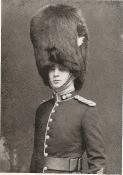
War Memorial
| Captain Humphrey Robertson BARKWORTH | |
|
2nd Battalion Northumberland Fusiliers attached to the 25th (Service) Battalion (2nd Tyneside Irish) Date of birth: 16th October 1891 Date of death: 3rd July 1616 Died of wounds aged -276 Buried at Warloy-Baillon Communal Cemetery Extension Plot I Row B Grave 8 |

|
| Humphrey Robertson Barkworth was born at 33 Oxford Terrace, Hyde Park in London on the 16th of October 1891 the third son of Major Harold Arthur Sandbach Barkworth, Border Regiment, and Mary Alma (nee Gadesden) Barkworth of 33 Oxford Terrace, Hyde Park, later of Nash Court, Marnhull in Dorset. He was christened at Christ Church, Epsom on the 25th of November 1891. He was educated at Hazelwood School until July 1905 where he was a member of the Choir. He was a member of the Cricket XI in 1904 and 1905 and of the Football XI in 1904. The school magazine wrote the following on his 1904 cricket season: - "A wild hitter with a horizontal bat; fields well on occasions." Of his 1905 cricket season they wrote: - "A fine hitter, but at present without defence. A good field and safe catch at point." They wrote of his 1904 football season: - "(Goal) - Just misses being a first rate custodian: not thoroughly reliable: has improved his kicking: at times a trifle slow in parting with the ball." On leaving the school the magazine wrote of him: - "....joins his brother at Wellington. He has been a useful member of both Elevens." He went on to Wellington College where he was in Mr. Roger's House from September 1905 to December 1908. From January to April 1909 he was educated by Messrs. Carlyle and Grigson after which he was educated by Mr H.M.S. Malden of Harley House, Frant near Tunbridge Wells. He applied for the examination to the Royal Military College Sandhurst on the 27th of August 1909 and successfully entered the College in 1910 where he was in E Company. He was commissioned as a 2nd Lieutenant in the 5th Battalion Northumberland Fusiliers on the 4th of March 1911. He joined the 2nd Battalion of his regiment at Sheffield in the April. He was promoted to Lieutenant on the 13th of August 1914. On the outbreak of war the battalion were based at Sabathu in India and, on the 20th of November 1914, they sailed from Karachi, landing at Plymouth on the 22nd of December. They embarked for France at Southampton on board the SS “Australind” landing at Le Havre on the 18th of January 1915 where he was appointed as Machine Gun Officer for the battalion and was commended to his General for his fine work. On the 17th of February 1915 the battalion relieved a battalion of the Suffolk Regiment in trenches on the canal bank at Ypres. The trenches were in poor condition and the temperature was well below freezing. The battalion were relieved on the night of the 19th of February when Humphrey Barkworth was evacuated to the rear suffering from frostbite. He embarked on board the "Carrishooke Castle" at Le Havre on the 26th of February and landed at Southampton the following day. A Medical Board sat at Caxton Hall on the 11th of March to consider his case: - "He was attacked on the 19th Feb with frostbite. The feet were swollen and painful. Swelling has subsided, but there is numbness in toes and feet especially left - he cannot bear any weight yet." He was declared as fit for general service at a Medical Board which sat on the 11th of May 1915 and joined the 3rd Battalion of his regiment at The Grange, East Boldon in County Durham the following day. He returned to the front later that month and rejoined his battalion in the field on the 29th of May while they were in billets at Herzeel. On the 14th of June 1915 the battalion was in trenches at Vierstraat, to the north east of Kemmel near Ypres, having relieved the 7th Battalion Rifle Brigade there two nights earlier. There was some concern that the Germans were trying to tunnel under a nearby trench which was occupied by the Suffolk Regiment to lay a mine but otherwise the day was described as "quiet - weather fine" by the battalion war diary. Three other ranks were wounded during the day and Humphrey Barkworth was also wounded while lying in front of the trenches. He was evacuated to the rear and embarked at Boulogne on board the Hospital Ship "St David" on the 21st of June and landed at Dover later the same day. He was promoted to Captain on the 17th of July 1915 and rejoined the 3rd Battalion at East Boldon on the 19th of September 1915 where he was placed on light duties. He was mentioned in despatches. A Medical Board was convened at Newcastle-upon-Tyne on the 15th of November 1915 which summarised his case: - "Near St Eloi was wounded by rifle bullet entering left chest about 3 1/2 inches from mid line and after traversing across chest and down left arm lodged in region of left elbow from which point it was removed at Wimereaux one week later. The track is soundly healed and there has been no damage to underlying lung. Power in left hand and arm normal so fit for general service." The following day he was appointed as Adjutant of the 25th Battalion of his regiment. He was well loved by his new men who called him their “Pup”. He was well known in the Regiment for keeping smartness and “Esprit de Corps” and started a fife and drum section for the battalion. The battalion landed in France at Le Havre at 8am on the 12th of January 1916. On the 1st of July 1916, the opening day of the Battle of the Somme, the 25th Battalion Northumberland Fusiliers were part of 103rd (Tyneside Irish) Brigade whose part in the attack was to advance along a line to the north west of the Albert -Bapaume Road towards La Boiselle in an area know to the British as “Mash” Valley. At 7.30am there was a huge explosion as a British mine went up signalling the advance to begin. The 25th Battalion started their advance from well behind the British front line, as the congestion in the forward trenches was so great. They advanced in lines 150 paces apart and for the first part of their move forward they were shielded from the Germans by a rise in the ground. As they appeared on the horizon walking in long lines, the German machine gunners and riflemen spotted them and they fell in rows as the machineguns worked back and forth down the lines of men. Most of the battalion did not make their own front line before they were cut down. Humphrey Barkworth was mortally wounded during the advance, refusing to have his wound dressed until those wounded around him had been attended to and he was carried away still cheering his men on. He was admitted to 92nd Field Ambulance where he died of his wounds two days later. Of the twenty officers and seven hundred and thirty other ranks who had started the advance, some sixteen officers and six hundred and ten other ranks were killed, wounded or missing at the end of the day. A fellow officer wrote:- “Humphrey is no longer with us but his name and his memory will live always, and for ever, our deepest sympathy goes to his mother and father”. He was a fine horseman, good at polo, cricket and all games. He is commemorated on the war memorial at Wellington College and on the memorial at the Royal Military College Sandhurst. His father, Major Harold Arthur Sandbach Barkworth Border Regiment died on the 28th of January 1917. |
|
| Went on to Wellington College |
Back